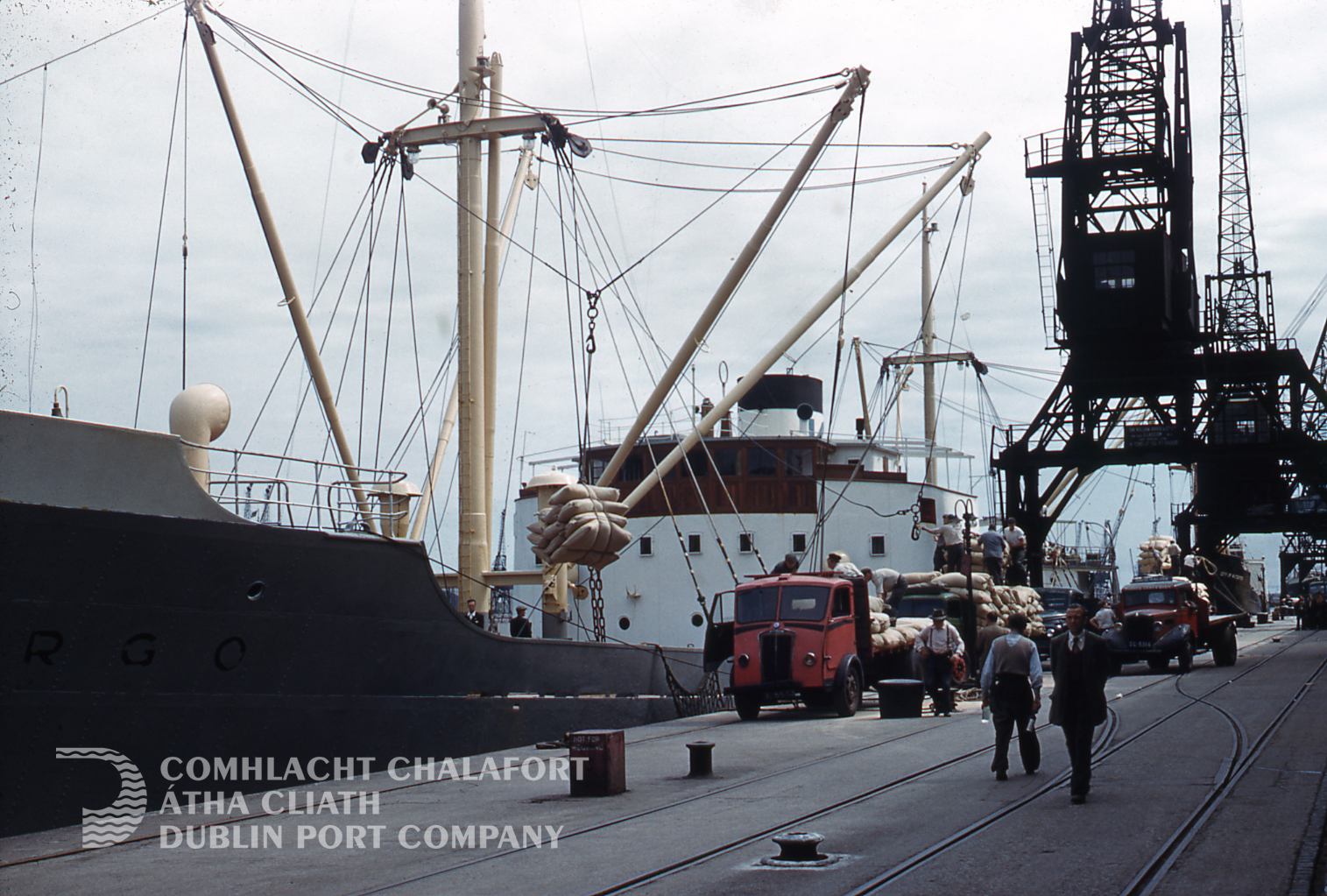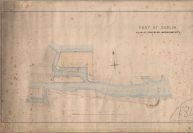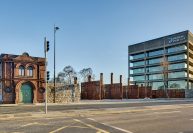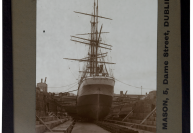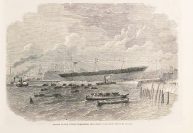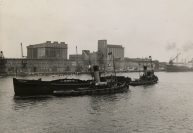A New Vision for an Old Space
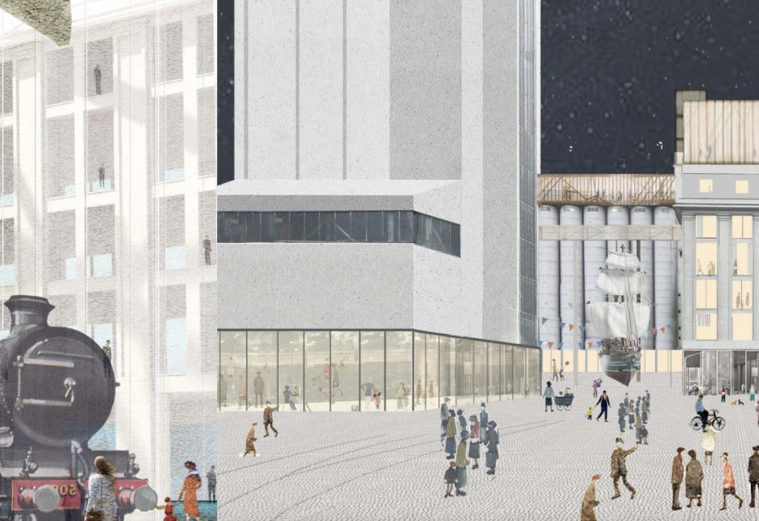
Shelley McNamara, Co-Director of Grafton Architects, and Jim Kelleher, Head of Special Projects at Dublin Port Company, discuss the ambitious plans to turn the old Odlum’s Mill in the Port into a stunning cultural area.
In December 2018, Dublin Port Company (DPC) issued a tender for an architect-led multi- disciplinary design team to create a Masterplan for the old Odlum’s Mill site in the Alexandra Basin.
This area consists of 1.37 hectares, which will become central to the future heritage plans for the Port, linking to the already planned 4.2km greenway along the northern edge of the Port. Eight companies made submissions and the internationally famous Grafton Architects were awarded the contract in May 2019. Over the next six months, the Masterplan has been developed with Jim Kelleher and Lar Joye of the Port Heritage & Communications Group, Grafton Architects and their consultants, which also involved meeting a variety of external stakeholders, including the Dublin Dock Workers Preservation Society.
“Grafton Architects have taken the old Odlum’s flour mill site and re-envisioned the entire concept, connecting it back to the city,” explains Jim Kelleher.
“The brief gave us a lot to think about in terms of what these buildings might be used for, mostly industrial buildings in different states of repair on an extraordinary site in the city,” explains Shelley McNamara, co-director and co-founder of Grafton Architects.
The biggest challenge, according to Shelley, was “to find a way of connecting the future life of the Flour Mill into the cultural life of the city and how the citizen and the city could feel that it would become part of their world”. She describes the area currently as “like an organ which has been detached waiting to be absorbed into the life of the city”.
“We also wanted to be really extravagant in our imaginings because it is such a theatrical and vibrant place, so we explored the potential of the site in terms of the city and the bay, because in that sense it is an entry point into Dublin,” Shelley notes.
As required in the design brief set by DPC, Grafton Architects’ plan involved input from a host of different disciplines, including industrial archaeologists, structural engineers, building services engineers, conservation architects, sustainability experts, economists etc, each of whom contributed to the final plan, which is a hugely ambitious project, creating a new cultural hub in the middle of the Port with the additional vibrancy of mixed uses, such as some port operations, archive and visitor attractions.
Grafton Architects’ initial findings were presented to the Board of Dublin Port Company in November 2019. This plan will create an area for the Port to house its nationally important archive, a Port museum, theatre, studios for artists, community rooms and operational facilities relocated from other parts of the Port. The possibility of including a hotel in the Flour Mill site was examined in detail, but ultimately it was decided against on the grounds of commercial viability.
A Portline to the Centre
The Starboard Home video, commissioned by Dublin Port Company to celebrate the musical project
from 2018, proved inspiring to the team at Grafton Architects. “It convinced us that being by the river and right on top of the activity of the Port is the place to be; it provides the theatre of the place,” Shelley reveals. “It would be so exciting to walk or cycle safely from the 3 Arena down to the Flour Mill area and engage with the different activities there.”
While initially toying with the idea of entering the Flour Mill from Alexandra Road, the Grafton Architects team changed their mind, and came up with a far more dramatic pathway to the new area.” Their plan allows for the construction of a 900m Portline, an elevated walkway similar to New York’s Highline, to take visitors into the Port, starting at the North Wall close to the 3 Arena and finishing in the Odlum’s Flour Mill.
“We looked at all the different walkways around the world, elevated and otherwise,” Shelley reveals. “We mapped the amount of time it would take to walk, and it talks approximately 15 minutes from the 3 Arena, and we were convinced it would be really exciting to be able to overlook the activity of the Port on that journey, and at the same time be able to access the new Flour Mill area.”
“It’s about getting the public into the Port without interrupting day-to-day port operations,” explains Jim Kelleher. “We are not knocking down anything but repurposing the infrastructure that is there to facilitate the changes occurring within the Port and to turn it into a visitor attraction, while ensuring that visitors can come into the Port safely.”
Urban Acupuncture
Maintaining the essence of the existing industrial buildings was important, both to Dublin Port Company and also to Grafton Architects.
“We felt it was important to keep as many of the existing structures as possible,” Shelley explains. “These buildings, especially the silos, are so extraordinary. We had done a lot of research in the past on reusing existing industrial sites, primarily through teaching as opposed to commissions, so we had quite a bank of precedents to draw from in terms of how you can make a site vibrant and lively without needing to add an enormous number of new things.”
She cites the concept of ‘urban acupuncture’, a socio- environmental theory that combines contemporary urban design with traditional Chinese acupuncture, as a guide to this development, as Grafton Architects set out “to hit a nerve that would act as a catalyst for other things to happen”. Those other things include the ancillary uses of the new area, which is to include a museum, a theatre, studio space for artists, and a conference venue, as well as buildings needed by DPC themselves, including office space and a building to house the extensive Port Archive.
“We wondered how could we use these semi-derelict buildings, to fix them up enough to be rehearsal spaces or exhibition spaces?” Shelley explains. “The city is crying out for those kind of spaces for appropriation. The way that land values and commerce is going in Dublin, artists are being squeezed out of the city, because they can’t afford a studio or a place to live. The idea is that there will be a cluster of different uses in the Flour Mill, including a market, artists’ studios, an experimental theatre, a formal theatre, a rooftop venue.”
The Spectacular Silos
The plan also makes use of the old Odlum’s grain silos themselves, such an instantly recognisable feature of the Port’s skyline. Given that the silos are made from steel rather than concrete, it was a challenge, but that didn’t stop the team at Grafton Architects from creating a hugely ambitious plan for these structures, which will house a visitor centre and a rooftop terrace, including a café bar and community resource area.
“We came around to thinking that something like the silos can be an artefact in themselves; they don’t have to become something else to be interesting,” Shelley reveals.
“To get under those big structures and feel the weight of what is above you, with hundreds of stiletto-heel columns coming down to the ground, and then to be able to get up on top of them and enjoy the incredible view over the city; you’re using the artefact without trying to overuse it. Also, by taking away the metal base of the silo, you are clearing a view to the river and unveiling the bottom of the silo itself. Sometimes when you overuse something, you lose the very thing that made it important or unique, which in this case is the rudimentary industrial quality those buildings have.”
The ground floor and top floor of the silos will form part of a visitors’ centre, with views underneath the silos and from their roof. “In between, we are collecting hot air from the south-facing silos, which will act like the bars of a radiator in absorbing heat from the sun, and we will use some of that to heat the café, bar and community resource on the roof,” reveals Shelley.
Grafton Architects also wanted to make the site even more visible. In their plan, the Vessel Traffic Service (VTS) will sit atop the old iconic grain silos tower, which will extend upwards to incorporate it: “It is symbolically fantastic, that the Harbour Master will overlook the entire Port”, Shelley explains.
The old Odlum’s mill itself is a heavy reinforced concrete building, which will house the Port museum. “It’s the most conventional building on the site, in that it has windows and floors, whereas the others are made up of huge voids and big, open spaces,” Shelley notes. “There’s a big outdoor area, with a lightweight roof, which we call the Great Hall, which can exhibit boats or other large machinery, while other exhibition spaces would happen within the mill building.”
Inspired by the stories of various seeds that were unwittingly brought into Dublin by ships over the centuries, the mill building’s roof will feature a roof garden, showing the kinds of plants that were introduced to the city in this way. The idea for this came from a Dublin Port Company project involving pupils from St Joseph’s Co-ed School, East Wall, and the 100 Flowers to Bloom exhibition.
The plan also includes a sizeable outdoor plaza which could host a market, another thing that Dublin has been crying out for since the demise of the open-air market at Newmarket Square in the Liberties.
Regular visitors to the Venice Architecture Biennale, where they won a Silver Lion for most promising practice in 2012, and curated the Architecture Biennale of 134 participants in 2018, Grafton Architects feel that Dublin could make use of its waterways in a similar way to the Italian city, where temporary bridges, using boats tied together, form an intrinsic and theatrical part of the event, perhaps for one-off events like New Year’s Eve when the work of the Port calms down, either taking large amounts of people or events like a light show.
“We were thinking of the Liffey as the foreground for a big display which could happen at the scale of the city, as well as thinking about how you could get people up onto the roof of the silos to enjoy the views over the city,” Shelley states.
Award-Winning Architects
Grafton Architects are no strangers to awards. Most recently, they were presented with the 2019 RIAI James Gandon Medal for Lifetime Achievement in Architecture, the highest personal award given to an architect in Ireland, and the 2020 Royal Gold Medal awarded annually by
the Royal Institute of British Architects in recognition of their significant lifetime contribution to the advancement of architecture, only the fourth time the award has been presented to Irish architects and only the second time it has been presented to female architects in over 100 years.
“Those awards are fantastic. They are a recognition of the practice but also of the people who commission us and give us the chance to create work, so we are always extremely grateful to clients who have taken us on board,” Shelley notes.
Their impressive portfolio includes the Universita Luigi Bocconi in Milan, which won a World Building of the Year Award, the University of Limerick Medical School, which was shortlisted for the RIBA Stirling Prize in 2013, and the ‘vertical campus’ building for Lima’s specialist engineering university (UTEC) in Peru, which won the inaugural RIBA International Prize in 2016. Their current projects include the ESB headquarters on Fitzwilliam Street in Dublin and the new Dublin City Library & Parnell Square Cultural Quarter. So where does the Flour Mill Masterplan project sit in their illustrious CV?
“We were genuinely excited to win this,” Shelley enthuses. “Winning a project is different to winning an award. Winning an award is wonderful because it recognises the past and hopefully gets you entry into the future, but to win a project like this in our own city means an awful lot to us.
“This project really stretches us to think of such an important piece of the city, and to work with a client body with amazing vision. They are a really inspiring client to work with. So the challenge for us was how we could, as architects, stitch into that vision with not straight building design, but strategic thinking, which is very important
at the scale of the city. We have never had a client like this or a programme like this, to make something which makes financial sense – it doesn’t have to make a profit but it has to be able to run itself – and also has to make a public contribution to the city.
“We also love the notion of climbing up and down, under and into those amazing structures and how you can occupy them. You would never design spaces like that, so it’s both liberating and challenging for us. It is like a dream for an architect because this is normally the kind of thing that is tagged on at the end of a project. But this is a very serious project, one which has been considered for a long time. It’s not prescriptive; it’s not a normal architectural project; but it is one that is full of possibilities.”
Jim Kelleher describes the Grafton Architects Masterplan as “a great vision for the city and the Port”.
Shelley agrees: “This is about making an intervention in the city which gives to the city something it really needs in terms of space, venues, a fantastic location and the possibility to connect it back to the history of the city and the Port, to make it accessible to citizens of Dublin. The Port and the city are economically and commercially connected but this is an opportunity to make them physically and culturally interconnected as well. It is a most extraordinary brief.”
Help us with the Archive
You can help us to preserve Dublin Port’s rich archival heritage by
donating items or seek advice from us on items in your safekeeping.
Get in touch by completing the contact form below.
We’d love to hear from you!
